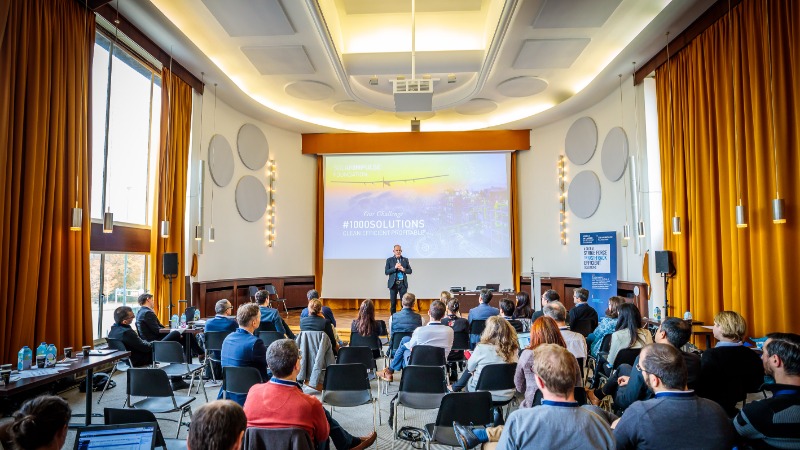Interviews - August 30, 2021
August's Expert of the Month: Arthur Parry!


Written by Jamie Wylie 5 min read
Our Experts are at the heart of the Solar Impulse Foundation, playing a vital role in assessing Solutions seeking the Efficient Solution Label. The Expert Community is made up of highly experienced people from science, engineering and business, with representation from over 50 countries.
Each month we recognise the hard work of an Expert who has gone above and beyond in their role. We are pleased to announce that the Expert of the Month for August is Arthur Parry! Arthur joined the Community in April this year, and has really impressed with his high quality assessments and scrutiny of prospective Solutions. Thank you for your dedication, Arthur!
In this article, we hear more about Arthur's experiences and expertise in the Circular Economy and more.
Please tell us a little about yourself!
Arthur: I am based in France, just across the border from Geneva in Switzerland, having moved from the UK around 17 years ago. I was originally trained as Mechanical Engineer, which was also my route into the recycling industry at the early part of my career.
Can you tell us about your area of expertise and profession?
My current work is focused on Sustainability Strategy and the Circular Economy. Following my time in the recycling industry, I worked for the best part of 20 years in the packaged goods industry, leading Innovation programs and, more latterly Platforming Strategies and Sustainability Strategies and activity systems. For the Sustainability Strategy work I am involved in my higher-level vision is to help organisations to eliminate the need for separate Sustainability organisations and activity systems, through the systematic integration of Sustainability into everything they do. For the Circular Economy I support companies who either have the intention from the start to operate with a fully circular business model, or who are looking to transform their existing linear model. One of the major considerations I can bring to this is around how to bring the approaches, systems and processes of large-scale global consumer goods brand to accelerate the implementation and adoption of the Circular Economy.
The Circular Economy has become a commonplace term in recent years. What are the most exciting trends or actions you see happening to move towards a Circular Economy?
For me one of the most exciting developments with the Circular Economy is associated with the increasing understanding that there is so much more to be gained from the approach than “simply” returning materials to manufacture. For example, in setting up a system in which products are returned for re-use, the designer of the model introduces not only a whole new set of interactions with their customers (which can be leveraged to drive loyalty, or to provide additional value-added services, in a way that is very hard to achieve with a traditional linear model) but also an opportunity to manage the “hub” of information flow for the entire ecosystem, and through this provide real-time, in-market data to improve their own offering and operation, but also that of all the various suppliers, distributors and retailers involved in the “Circle”. In this way it is possible to maintain value for all involved, and to provide growth opportunities which are not uniquely predicated on ever-increasing resource consumption.
During your time working for a major player like P&G, how did you find the business approach to sustainability shifted over the years?
Not necessarily linked only to P&G, but in more general, it is clear that the thinking on sustainability has substantially moved from one of threat to one of opportunity. This is a trend that still has a long way to go, but which has already seen many major players move from questions such as “what do we need to do to comply?” or “what do we need to do in order to mitigate threats to our cost structure?”, to “how can a sustainable future help us to transform the way we do business?”. To this last point, this is where challenging long-standing, often tacet, linear assumptions can open up not just new revenue streams, as explained in my answer on the Circular Economy, but also the opportunity to provide greater choice to a greater proportion of the population.
What barriers need to be overcome to move towards a more Circular Economy, and what new solutions are needed?
This is an excellent question and one which, in my view, is not discussed often enough! In short, the barriers tend to fall in three areas, each of which needs to be addressed:
Involvement of stakeholders and community: The Circular Economy demands (and thrives upon) a much higher degree of collaboration with all stakeholders in the circular community. If any stakeholder begins to feel the pinch (perhaps due to reduced margins) they will be forced to revert to a linear approach.
Financial analysis and justification - new business models, alternative revenue streams, cost optimisation through scale. Adopting the Circular Economy requires a different way of thinking about margins, profitability and growth – put very simply, squeezing margins will ultimately harm the value of the materials returned to the start of the loop. This means that a Circular Business Model cannot be properly evaluated using the tools and measures of a traditional linear, consumption-growth based model.
Closing the loop - systems, legislation, infrastructure: Existing laws, regulations, tax principles and governance standards are almost exclusively based on linear models, and for the most part do not actively support a Circular transition. Similarly, the Circular Economy implies changes to physical and digital infrastructure, required to keep materials in use at their highest possible value-state. It can appear prohibitively expensive or complex for someone attempting to create a Circular Business Model to take on the task of putting this infrastructure in place.
Action is needed from the ground-up, by innovators and communities working together, and simultaneously by governments and policy makers, in order for a successful transition to happen.
What kinds of solutions have you assessed as an Expert with the Solar Impulse Foundation? Which solutions have impressed you most, and why?
I have been delighted by the variety of Solutions I have seen so far, and by the quality of the submissions. Clearly a lot of what I have assessed are founded on Circular principles, but the industries impacted have ranged from logistics to food packaging and to building materials, to name just a few. I tend to be most impressed with the submissions which challenge an existing paradigm and seek to address the environmental concerns through a systematic approach to the design (rather than, for example, attempting to resolve just one discrete issue).
What are your hopes for the Labeled Solutions, and the mission of the Solar Impulse Foundation more widely?
The fact that the collection of Labeled Solutions can increasingly serve as a suite of readily available best practices is of tremendous value. Not only does it enable those looking for solutions to more easily find what they are looking for, but it can also act as a catalyst for acceleration if, for example, two or more Solutions can later be combined to even greater effect than they could achieve alone. I believe it is incumbent upon the Solar Impulse Foundation, having put this in place, to continuously push the bar upwards with regards to both the standard of the Solutions identified and the active implementation of those solutions throughout the world.
Interested in becoming an Expert with the Solar Impulse Foundation? Find out more here.

Written by Jamie Wylie on August 30, 2021


